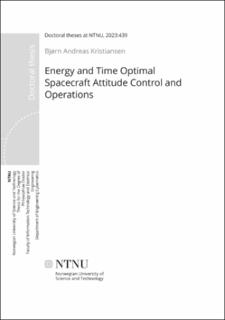| dc.description.abstract | In this thesis, we present a cost function based on net power as a way to make attitude control maneuvers energy optimal for solar-powered spacecraft. Previous work has defined energy optimality in terms of input norms or, in some cases, actuator-based power models. The net power solution presented here is a cost function defined by the difference between the solar power the spacecraft gains at a given time minus the power it spends on actuation. Our solution is investigated both when the attitude control system is isolated and for a case where the full operations of a satellite are considered, displaying the benefits of this strategy in holistic satellite operations. The primary benefit of this method is that the time the satellite spends pointing towards the optimal solar attitude is maximized. This is evident from the smaller, isolated simulation study, which is performed solely based on the attitude control system, but the impact of this improvement becomes evident when the full operations of an agile satellite are considered, as the extra energy gained from the attitude control system could potentially increase the number of observations the satellite can perform per orbit. This net power concept is also investigated for a satellite actuated by magnetorquers, combined with a minimum time objective.
The second part of this thesis looks into maximum hands-off control for attitude control. Maximum hands-off control is a type of optimal control where the zeroth norm of the input is minimized, making the control signal as sparse as possible. Due to the zeroth norm being discontinuous, the L1- and L2-norm are common approximations to solve the maximum hands-off control problem. Having nice differentiation properties is particularly important due to the method we want to use to solve the problem: a Newton-type solver named IPOPT. We choose a different relaxation of the problem than the L1- and L2-norm to solve the maximum handsoff problem. From the results, we demonstrate the feasibility of this control method for attitude control, both for satellites actuated by reaction wheels and by on/off thrusters producing pure torque and a method of moving the sparsity around to where the operator desires.
The final part of this thesis is devoted to the slew maneuver that HYPSO-1 satellite, a 6U CubeSat from NTNU SmallSat lab used as the basis for several case studies in this thesis, performs. The slew maneuver has constant angular velocity in LVLH, a local frame that follows the satellite’s orbit. In the first chapter of this part, we investigate whether a second-order sliding mode controller named generalized super-twisting algorithm improves the attitude control system’s performance when the satellite points and performs the slewing maneuver in a simulation environment. In the final chapter, we analyze the connection between the attitude control telemetry from the satellite’s operations and its data products, looking at how well the satellite performs with respect to its science requirements and otherwise theorized performance. | en_US |
